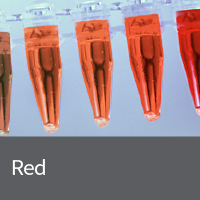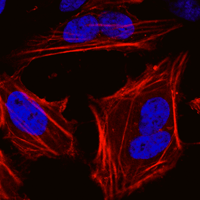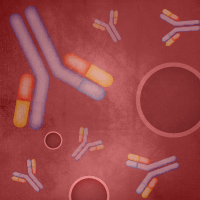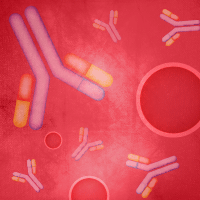632404
pDsRed2 Vector
20 ug
USD $615.00
pDsRed2 encodes DsRed2, a variant of the Discosoma sp. red fluorescent protein (DsRed). DsRed2 contains six amino acid substitutions that accelerate chromophore maturation and decrease protein aggregation. In addition, the coding sequence for DsRed2 contains a series of silent base-pair changes for higher expression in mammalian cells. In pDsRed2, the DsRed2 coding sequence is flanked by two separate MCS regions at the 5' and 3' ends, making it possible to excise and shuttle the DsRed2 coding region into other expression vectors. pDsRed2 is intended to serve as a source of the DsRed2 cDNA; It can also be used in bacteria to produce DsRed2 protein.
Notice to purchaser
Our products are to be used for Research Use Only . They may not be used for any other purpose, including, but not limited to, use in humans, therapeutic or diagnostic use, or commercial use of any kind. Our products may not be transferred to third parties, resold, modified for resale, or used to manufacture commercial products or to provide a service to third parties without our prior written approval.
632405
pDsRed2-1 Vector
20 ug
USD $615.00
pDsRed2-1 encodes DsRed2, a variant of the Discosoma sp. red fluorescent protein (DsRed). DsRed2 contains six amino acid substitutions that accelerate chromophore maturation and decrease protein aggregation. In addition, the coding sequence for DsRed2 contains a series of silent base-pair changes for higher expression in mammalian cells. pDsRed2-1 can be used as a reporter to monitor the activity of promoters and promoter/enhancer combinations cloned into the multiple cloning site (MCS) upstream of the promoterless DsRed2 gene. Without the addition of a functional promoter, this vector will not express DsRed2.
Notice to purchaser
Our products are to be used for Research Use Only . They may not be used for any other purpose, including, but not limited to, use in humans, therapeutic or diagnostic use, or commercial use of any kind. Our products may not be transferred to third parties, resold, modified for resale, or used to manufacture commercial products or to provide a service to third parties without our prior written approval.
632406
pDsRed2-N1 Vector
20 ug
USD $615.00
pDsRed2-N1 encodes DsRed2, a variant of Discosoma sp. red fluorescent protein, (DsRed). DsRed2 contains six amino acid substitutions that accelerate chromophore maturation and decrease protein aggregation. In addition, the coding sequence for DsRed2 is human codon-optimized for higher expression in mammalian cells. pDsRed2-N1 allows genes to be cloned into the multiple cloning site (MCS) upstream of the DsRed2 coding sequence to be expressed as fusions to the N-terminus of DsRed2. The unmodified vector will express DsRed2 in mammalian cells.
Notice to purchaser
Our products are to be used for Research Use Only . They may not be used for any other purpose, including, but not limited to, use in humans, therapeutic or diagnostic use, or commercial use of any kind. Our products may not be transferred to third parties, resold, modified for resale, or used to manufacture commercial products or to provide a service to third parties without our prior written approval.
632407
pDsRed2-C1 Vector
20 ug
USD $615.00
pDsRed2-C1 encodes DsRed2, a variant of the Discosoma sp. red fluorescent protein (DsRed) that has been engineered for faster maturation and lower, non-specific aggregation. DsRed2 contains six amino acid substitutions that accelerate chromophore formation and decrease protein aggregation. In addition, the coding sequence for DsRed2 is human codon-optimized for high expression in mammalian cells. pDsRed2-C1 allows genes cloned into the multiple cloning site (MCS) downstream of the DsRed2 coding sequence to be expressed as fusions to the C-terminus of DsRed2 in mammalian cells.
Notice to purchaser
Our products are to be used for Research Use Only . They may not be used for any other purpose, including, but not limited to, use in humans, therapeutic or diagnostic use, or commercial use of any kind. Our products may not be transferred to third parties, resold, modified for resale, or used to manufacture commercial products or to provide a service to third parties without our prior written approval.
632408
pDsRed2-Nuc Vector
20 ug
USD $615.00
pDsRed2-Nuc encodes Discosoma sp. red fluorescent protein (DsRed2) fused with three copies of the nuclear localization signal (NLS) of the SV40 T-antigen. The NLS sequences are fused to the 3'-end of DsRed2. DsRed2 is a human codon-optimized variant of wild-type DsRed that has been engineered for faster maturation and lower non-specific aggregation. pDsRed2-Nuc is designed for fluorescent labeling of the nucleus in living cells.
Notice to purchaser
Our products are to be used for Research Use Only . They may not be used for any other purpose, including, but not limited to, use in humans, therapeutic or diagnostic use, or commercial use of any kind. Our products may not be transferred to third parties, resold, modified for resale, or used to manufacture commercial products or to provide a service to third parties without our prior written approval.
632409
pDsRed2-ER Vector
20 ug
USD $615.00
pDsRed2-ER is a mammalian expression vector designed to label the endoplasmic reticulum in living cells. The vector encodes a fusion consisting of Discosoma sp. red fluorescent protein (DsRed2); the endoplasmic reticulum (ER) targeting sequence of calreticulin, fused to the 5' end of DsRed2; and the ER retention sequence, KDEL, fused to the 3' end of DsRed2. DsRed2 is a human codon-optimized variant of wild-type DsRed that has been engineered for faster maturation and lower non-specific aggregation.
pDsRed2-ER can be introduced into mammalian cells using any standard transfection method. If required, stable transformants can be selected using G418.
Notice to purchaser
Our products are to be used for Research Use Only . They may not be used for any other purpose, including, but not limited to, use in humans, therapeutic or diagnostic use, or commercial use of any kind. Our products may not be transferred to third parties, resold, modified for resale, or used to manufacture commercial products or to provide a service to third parties without our prior written approval.
632418
pDsRed2-Peroxi Vector
20 ug
USD $615.00
pDsRed2-Peroxi encodes a fusion of Discosoma sp. red fluorescent protein (DsRed2) and the peroxisomal targeting signal 1 (PTS1). The PTS1 sequence is fused to the 3'-end of DsRed2 and encodes the tripeptide SKL, which targets the fusion protein to the matrix of peroxisomes. DsRed2 is human codon-optimized for high expression in mammalian cells. pDsRed2-Peroxi is designed for fluorescent labeling of peroxisomes.
Notice to purchaser
Our products are to be used for Research Use Only . They may not be used for any other purpose, including, but not limited to, use in humans, therapeutic or diagnostic use, or commercial use of any kind. Our products may not be transferred to third parties, resold, modified for resale, or used to manufacture commercial products or to provide a service to third parties without our prior written approval.
632419
pDsRed2-Bid Vector
20 ug
USD $615.00
pDsRed2-Bid encodes a fusion of Discosoma sp. red fluorescent protein (DsRed2) and Bid, a member of the Bcl-2 family. In healthy, non-apoptotic cells, Bid resides in the cytosol as soluble protein. Upon induction of apoptosis, Bid translocates to mitochondria. In cells expressing the Bid-DsRed2 fusion, the translocation can be detected by fluorescence microscopy.
Notice to purchaser
Our products are to be used for Research Use Only . They may not be used for any other purpose, including, but not limited to, use in humans, therapeutic or diagnostic use, or commercial use of any kind. Our products may not be transferred to third parties, resold, modified for resale, or used to manufacture commercial products or to provide a service to third parties without our prior written approval.
632420
pIRES2-DsRed2 Vector
20 ug
USD $615.00
Bicistronic expression vector containing DsRed2 as a marker for transfection efficiency. A gene of interest is inserted into the MCS located upstream of the encephalomyocarditis virus (EMCV) internal ribosomal entry site (IRES). The IRES sequence allows both the gene of interest and DsRed2 to be translated simultaneously from the same mRNA transcript. DsRed2 is a human codon-optimized variant of wild-type DsRed that has been engineered for faster maturation and lower non-specific aggregation.
Notice to purchaser
Our products are to be used for Research Use Only . They may not be used for any other purpose, including, but not limited to, use in humans, therapeutic or diagnostic use, or commercial use of any kind. Our products may not be transferred to third parties, resold, modified for resale, or used to manufacture commercial products or to provide a service to third parties without our prior written approval.
632421
pDsRed2-Mito Vector
20 ug
USD $615.00
pDsRed2-Mito encodes a fusion of Discosoma sp. red fluorescent protein (DsRed2) and a mitochondrial targeting sequence of human cytochrome c oxidase subunit VIII (Mito). The targeting sequence is fused to the 5'-end of DsRed2, which is human codon-optimized for high expression in mammalian cells. pDsRed2-Mito is designed for fluorescent labeling of mitochondria.
Notice to purchaser
Our products are to be used for Research Use Only . They may not be used for any other purpose, including, but not limited to, use in humans, therapeutic or diagnostic use, or commercial use of any kind. Our products may not be transferred to third parties, resold, modified for resale, or used to manufacture commercial products or to provide a service to third parties without our prior written approval.







